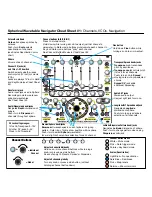
Basic Structure
Internal Structure (System Overview)
118
Owner’s Manual
Audio Input Part (AUDIO IN)
The Performance mode and Multi mode are capable of handling the audio input signal (such as a microphone or
guitar) as a Part. Various parameters such as volume, pan, and effect can be set to this Part and the sound is output
together with other Parts. Other available settings include how stereo input signals are handled, as well the output
assignment of the audio Part. These parameters are set and stored for each Performance and Multi. Please note that
the Audio Input Part is not available in the Voice mode.
Parameters for the above Parts can be set with the following operations.
n
Although the Insertion Effects of this synthesizer can be applied to the A/D Input Part, they cannot be applied to the mLAN Input Part.
Effect Block
This block applies effects to the output of the tone generator block, processing and enhancing the sound using
sophisticated DSP (digital signal processing) technology.
Effect structure
The effect processing of this synthesizer features the System Effects, Insertion Effects, Master Effect, Part EQ (Equalizer),
and Master EQ (Equalizer).
■
System Effects (Reverb, Chorus)
System Effects are applied to the overall sound, whether it be a Voice, an entire Performance, and an entire Multi.
With System effects, the sound of each Part is sent to the effect according to the effect Send Level for each Part. The
processed sound (referred to as “wet”) is sent back to the mixer, according to the Return Level, and output—after being
mixed with the unprocessed “dry” sound. This arrangement lets you prepare an optimum balance of the effect sound and
the original sound of the Parts.
Reverb
The Reverb effects add a warm ambience to the sound, simulating the complex reflections of actual performance spaces,
such as a concert hall or a small club. A total of 20 different Reverb types are available.
Chorus
The Chorus effects use various types of modulation processing, including flanger and phaser, to enhance the sound in a
variety of ways. A total of 49 types are available, including reverb and delay effects.
■
Insertion Effects A, B
Insertion effects can be applied individually to each part. Insertion effects are mainly used to directly process a single part.
The depth of the effect is adjusted by setting the dry/wet balance. Since an Insertion effect can only be applied to one
particular part, it should be used for sounds you want to drastically change or for sounds that use an effect unintended for
other sounds. You can also set the balance so that only the effect sound is heard, by setting Wet to 100%.
This synthesizer features eight sets of Insertion effects (one set has A and B units). They can be applied to all parts of the
Performance, and applied to eight parts (maximum) of the Multi.
A total of 117 different Chorus types are available.
n
In the Voice mode, only one set of the Insertion effects is available.
n
Among the AUDIO IN Parts, Insertion effects cannot be applied to the mLAN Parts.
A/D input Part
This part (one stereo part) is input from the external audio equipment connected to the A/D INPUT jack.
mLAN Input Parts (when the optional
mLAN16E has been installed)
These four stereo parts are input from external mLAN-compatible audio equipment connected to the
mLAN jack via a single IEEE1394 cable.
In the Performance mode
[PERFORM]
→
Performance selection
→
[EDIT]
→
[COMMON]
→
[F5] AUDIO IN
In the Multi mode
[MULTI/SEQ PLAY] (select Multi mod)
→
Multi selection
→
[EDIT]
→
[COMMON]
→
[F5] AUDIO IN


































